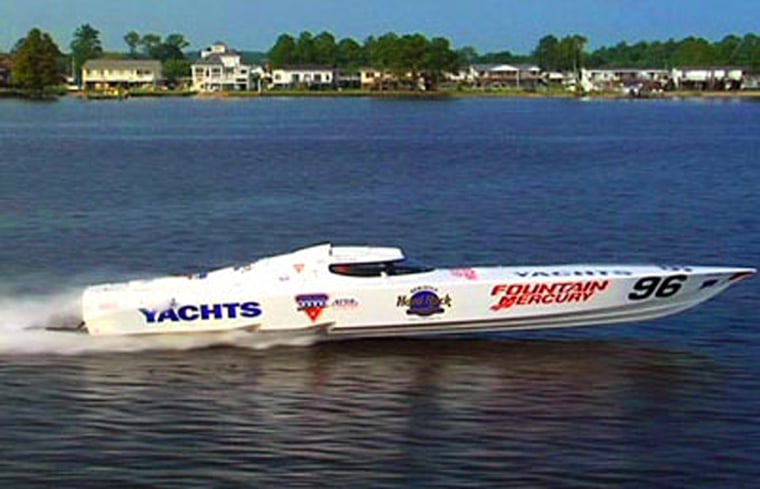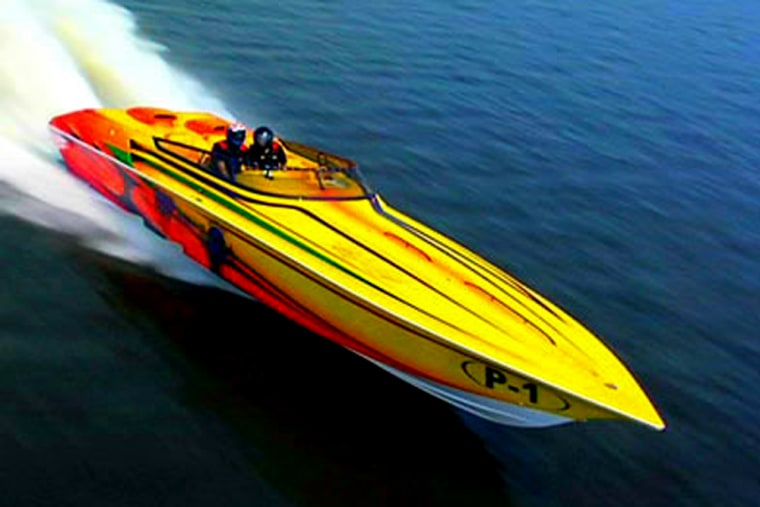We've gathered at Fountain Powerboats' headquarters on the secluded banks of the Pamlico River, in Washington, N.C. It's a humid, 91-degree day in August. Dressed in a helmet, wet suit and life jacket, I can feel my heart pounding and my palms sweating. A crew member connects a black cord from my waist to the 47-foot, 2,700-horsepower boat I'm about to ride. The cord seems flimsy for a seat belt, so I inquire. "Oh, that?" says the crewman nonchalantly. "That's the kill-cord. If you crash and get ejected, it'll kill the engine and stop the boat."
OK, but what about me? That depends. In a high-speed crash, he says, the angle at which I hit the water will determine the extent of my injuries. If I hit obliquely and skip along the surface like a flat stone, I'll have a decent chance of surviving. But if I hit like a sinker — if my body catches and stops suddenly — the g-forces will break my back and neck. I won't live to know what happened.
I've driven fast before — 200 miles per hour in an Indy car. But water isn't pavement. A river's surface is constantly changing in three dimensions, tugged by wind and current. Racing on it demands fast reflexes and perfect balance — as if you were running up a down escalator without handrails. There are also floating hazards — logs, sea turtles, garbage. Hit any of these at the speeds we are attempting, and the boat can flip, nose-dive or disintegrate, depending on the size of the object and the angle of collision.
I train rigorously for most of my adventures. But the last time I was in a boat was in 2000, and it was a Russian icebreaker en route to the North Pole. So, my first day at Fountain was devoted to instruction. I started in a 42-foot-long Super Vee canopy boat, the fastest and safest in its race class. Powered by twin 525-horsepower Mercury engines, the Super Vee is capable of speeds of over 110 mph.
Unlike auto racing, where it's just you in your car, boat racing requires a team of two — one to work the throttle, another to steer. Since steering is the "easier" of the two, I was assigned the wheel. On throttle was Reginald Fountain, 67, a champion racer of superboats and chief executive of the boat-building company he founded in 1978. John Carbonell, president of Super Boat International, a sanctioning body for high-speed races, was on hand to watch.
Strapped into my seat with five belts clasped so tight that it was hard to breathe, I felt slightly claustrophobic, especially once the canopy was closed and sealed. Gauges litter the cockpit. Fountain told me not to pay them any heed; he would take care of them. All I had to do was steer — and in a straight line.

While still warming up and traveling maybe 70 mph, we hit a rogue wave. It came out of nowhere, and I had no time to prepare. The effect on the boat was intense and frightening. The nose lurched up — 45 degrees off the water — then plummeted. Fountain, out of instinct, backed off the throttle immediately. What would have happened, I asked, if we'd hit the wave at full speed? We could have flipped and submerged in the black water. When that happens, Fountain told me, the best thing to do is remain calm, upside down, inside the canopy. Oxygen masks attached to our belts would keep us breathing until divers arrived to extract us.
After several practice runs, each at a higher speed, I got the go-ahead for a high-speed trial run. My previous race-car driving experience helped. At high speed in an auto, smoothness and concentration are everything. Here, too. Before I knew it, we had the thing up to 100 mph. The faster you go in one of these boats the easier it handles. At our top speed of 112 mph the sensation is one of near serenity. Piece of cake.
When morning dawned, hot and humid, the next day, we were told there had been a change of plans. The bigger, more powerful canopied boat I was supposed to drive developed engine trouble. So I was assigned a P-1, the largest of Fountain's production boats, a 47-foot monster with twin 1,350-horsepower Sterling engines. It's a different animal entirely. You stand up to drive it. There are no seat belts. And there's no canopy. Your head is exposed to the elements, and your body is secured to the boat only by the aforementioned kill-cord. The rationale here is that in a crash it's better to be thrown free, so you won't be dragged under or crushed by the boat. With no canopy, the wind hits you squarely in the face, forcing your helmet back so hard that your neck muscles ache.
After an hour of trial runs, Fountain eased out the throttle, gently at first, then more, then flat out. The power was enormous. In 60 seconds we were cruising at well above 100 mph.
Near its top speed the P-1 handles like an airplane, as if you were flying. That's because you are, kind of — most of the boat is out of the water. Our speedometer, which relied on GPS, flirted with 140 mph. Ahead, the green buoys that marked the end of the course were rapidly approaching — did Fountain see them? When at last he eased off, the boat immediately slowed and settled back into the water.
Afterward Fountain told me that the boat is capable of 142 mph, but the midday heat made the air too thin for the engines to produce maximum horsepower.
You can try this yourself. The 42-foot Fountain Super Vee costs around $550,000; the Fountain P-1 is $300,000 more. You can even compete on the racing circuit. Just like Nascar and the Indy Racing League, Super Boat holds a series of races — 16 of them this year, from New York to Key West, Fla. Race classes are determined according to a boat's size and power. Fastest are the "unlimiteds," such as the P-1. Most Super Boat drivers have careers and race only as a hobby. Depending on what class you compete in, a season can cost anywhere from $200,000 to $1.5 million (excluding the cost of the boat). Prizes? Don't get your hopes up. Says John Carbonell, grinning, "It takes a large fortune to make a small one boat racing."
Get yourself a good throttle man. Mine was the best.
